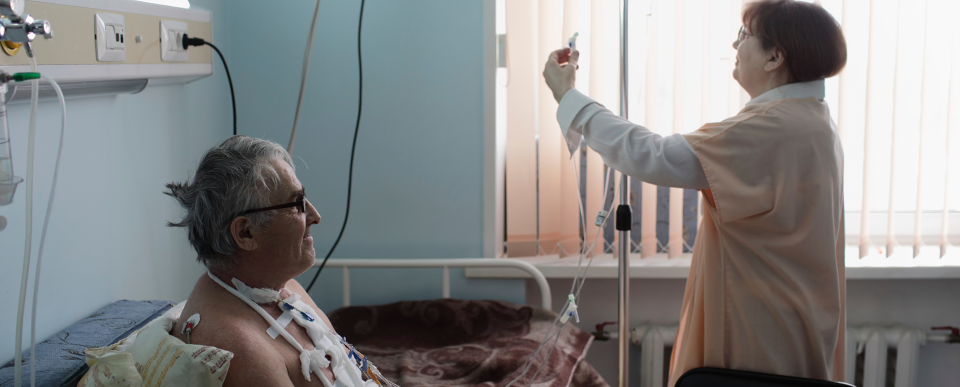Blackline Safety is a technology leader driving innovation in the industrial workforce through IoT (Internet of Things). With connected safety devices and predictive analytics, Blackline enables companies to drive towards zero safety incidents and improved operational performance. Blackline provides wearable devices, personal and area gas monitoring, cloud-connected software and data analytics to meet demanding safety challenges and enhance overall productivity for organizations with coverage in more than 100 countries. Armed with cellular and satellite connectivity, Blackline provides a lifeline to tens of thousands of people, having reported over 200 billion data-points and initiated over seven million emergency alerts. For more information, visit BlacklineSafety.com and connect with us on Facebook, Twitter, LinkedIn and Instagram.
Lone Workers & Violence - What You Need to Know
Blackline Safety, Leader in Connected Gas Detection & Lone Worker Safety
August 19, 2015
We recently sat down with Brendon Cook, CTO and cofounder at Blackline Safety, to discuss prevalent risks lone workers face but don’t always talk about — aggressive behavior, physical or sexual assaults and violent attacks that can even result in workplace fatalities.
Check out our Q&A with Brendon.
HOW MANY WORKPLACE FATALITIES ARE A RESULT OF VIOLENCE?
When asked about safety incidents in the workplace, many individuals immediately think about the many ways employees can be injured. And with an aging workforce, health incidents are becoming an increasing area of concern, as well. But according to the National Safety Council (NSC), violence is the second highest cause of workplace deaths annually and accounts for 17.7 percent of workplace fatalities in the United States — second to transportation incidents at 39.6 percent. According to the National Institute for Occupational Safety and Health (NIOSH), every year in the United States 1.7 million workers are injured due to workplace assaults.
 This aggressive workplace topic spans every industry — including manufacturing, natural resources, real estate, retail, utilities, government and healthcare sectors. Also, it’s not related to just those industries that have interaction with the public — risk in the workplace can come from within an organization.
This aggressive workplace topic spans every industry — including manufacturing, natural resources, real estate, retail, utilities, government and healthcare sectors. Also, it’s not related to just those industries that have interaction with the public — risk in the workplace can come from within an organization.
ARE COMPANIES BEING HELD RESPONSIBLE FOR SEXUAL HARASSMENT & VIOLENCE IN THE WORKPLACE?
Some corporations are paying hefty fines for not protecting their employees.
According to KQED News, 21 California women — many of them janitorial staff — were part of a U.S. Equal Employment Opportunity Commission lawsuit that claimed ABM failed to protect them from sexual harassment and assault by 14 men who were also employed by the company. In 2010, the banking conglomerate settled the sexual harassment lawsuit for $5.8 million.
ABM is among 15 U.S. corporations that the federal government has targeted numerous times for sexual harassment.
The recent PBS Frontline documentary, “Rape on the Night Shift,” also explores the risks to women working in the janitorial area, and reported that 50 women a day are raped in their workplace in the United States.
 Every employer has a duty of care to its personnel, to provide a safe work environment — free from risk of injury and workplace violence. Any organization that has not provided the groundwork for a safe work environment has left the door open for risk to the business and the welfare of its employees. Workplace violence is not acceptable and is avoidable.
Every employer has a duty of care to its personnel, to provide a safe work environment — free from risk of injury and workplace violence. Any organization that has not provided the groundwork for a safe work environment has left the door open for risk to the business and the welfare of its employees. Workplace violence is not acceptable and is avoidable.
HOW CAN WORKPLACE VIOLENCE BE AVOIDED?
An organization’s management team is critical to creating the infrastructure to proactively address workplace violence through policy, monitoring and action. In the province of Ontario, Canada, safety regulations require that every provincial employer prepare and review annually a policy on workplace violence — something that we would recommend to every organization.
According to the Canadian Centre for Occupational Health and Safety, workplace bullying includes spreading malicious or untrue rumors, socially isolating individuals, physically injuring someone, threatening others, blocking a co-worker’s movements, setting unattainable goals, yelling and swearing, and hindering work on purpose. Bullying is just one of many workplace violence problems, but these behaviors can cause a situation to spiral out of control if not monitored and addressed properly.
 Sexual harassment is another important topic in the workplace. Every employee has the right to work in an environment free of uninvited, unwanted, and offensive behavior from others. This topic should be considered head-on within a workplace violence policy.
Sexual harassment is another important topic in the workplace. Every employee has the right to work in an environment free of uninvited, unwanted, and offensive behavior from others. This topic should be considered head-on within a workplace violence policy.
The state of employee mental health is one that should not be overlooked and may become a trigger to a future incident. According to the International Labour Office (ILO), mental health should be seen similar to how our culture considers those with physical disabilities and their associated rights. Further, the ILO indicates that clinical depression is one of the most common illnesses affecting working adults. Employers with personnel who are suffering from mental health and stress management challenges should proactively consider a workplace mental health policy to help identify situations and provide assistance where needed.
WHAT SAFETY OPTIONS ARE AVAILABLE FOR LONE WORKERS?
As with all safety programs, employers should begin with a risk assessment and review their workplace violence and mental health policies. If these policies are not in place, an internal review should be considered to put these in place.
Next, the employer should consider the safety monitoring options available. These solutions range from manual check-in processes and supervisory spot checks to the use of modern safety monitoring technology, such as offered by our Loner solutions. Our Safety Monitoring Solutions Comparison Guide provides an objective view of each approach.
WHAT PRODUCT FEATURES DOES BLACKLINE SAFETY OFFER TO HELP LONE WORKERS SUFFERING WORKPLACE VIOLENCE?
A key feature of Blackline’s Loner family of employee safety monitoring solutions is its emergency latch — a feature that can be triggered as easily as pulling a fire alarm lever. Due to its design, it can be triggered even without looking and delivers a real-time alert to monitoring personnel who will manage an immediate emergency response. This feature also includes bright, flashing lights and an audible alarm that will draw attention to the situation from passersby.
We also offer a silent emergency feature that can be used to trigger a request for help without flashing lights or an audible alarm. A silent emergency request calls for help discretely, potentially without aggravating a situation further.
In addition to requesting help in real-time, we offer precise positioning technology that helps monitoring personnel coordinate an emergency response to the employee’s location. We use GPS for outdoor positioning and have developed our own indoor location technology for precise positioning of personnel working within complex facilities. Floor plans are included that provide critical oversight required when managing an indoor emergency response. When responding to an incident, every second counts, and technology can make the difference.
Should a situation occur where an employee is rendered unconscious, our Loner solutions incorporate fall detection and person-down/motionless technology. Both of these features are automatic and triggered when the employee cannot call for help on their own.
ABOUT BRENDON COOK
Cook is Blackline’s Chief Technology Officer and a co-founder of Blackline Safety. He was awarded a B.Sc. in Geomatics Engineering from the University of Calgary. Prior to founding Blackline in 2004, he worked for Calgary-based CSI Wireless (now Hemisphere GNSS) as its Product and Marketing Manager and developed business relationships with international organizations.

UP NEXT
Stay tuned for our next post, in which we will explore The Dangers Awaiting Your Staff: 8 Times Not to Undervalue Safety. Don’t miss it! Subscribe to our blog today by submitting your email address in the form to the right.
And, in case you missed previous posts in this series, check out the Top 8 Elements for a Successful Employee Safety Monitoring Program and The True Cost of Not Investing in Safety Monitoring.
Get In Touch
Let’s start a discussion about your safety challenges and needs.
Related Blog Posts
Real-life Incident: Anna’s Story – Heart Attack While Working Alone
January 22, 2025
‘Please hurry!’How Anna’s G7 Saved Her Life Pain ripped through Anna’s chest and back, taking her breath away. She felt dizzy and like she was...
Real-Life Incident: Leo’s Story - Stranded in the Wilderness
December 13, 2024
'I am stranded': Well site inspector credits Blackline connected wearable device for facilitating remote backcountry rescue Leo felt the quad’s...
Real-life Incident: James’ Story – Knocked Unconscious by a Fall
October 09, 2024
'The G7’s alarm woke me up': Tank inspector credits G7 for waking him and agent for staying with him after suffering severe concussion while working...


